Saigoku Kannon Pilgrimage: Nariai-ji (æˆç›¸å¯º)
Our pilgrimage takes us next to Nariai-ji, temple 28, located in the northern reaches of Kyoto Prefecture. Getting there is a task, but the temple is located on a hill above Amanohashidate, which makes for a great day or even weekend trip.
Amanohashidate is one of the three traditionally recognized Most Scenic Places in Japan (the others being Miyajima and Matsushima); it’s worth noting that all three have a certain charm that comes from this status. They were tourist destinations 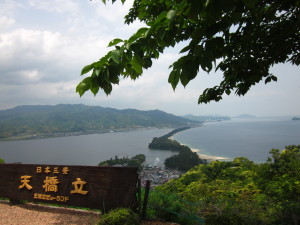 before photography, but tend not to be quite as overwhelming or overrun as, say, the iconic Kiyomizu-dera. Still, their surrounding tourist service areas being both old and in consistent use means an earthier feel to them, not so much with the flashing lights you might find at other tourist locales, but also not a ghost-town feel, as the destination is still on the list for many visitors, Japanese and foreign alike.
before photography, but tend not to be quite as overwhelming or overrun as, say, the iconic Kiyomizu-dera. Still, their surrounding tourist service areas being both old and in consistent use means an earthier feel to them, not so much with the flashing lights you might find at other tourist locales, but also not a ghost-town feel, as the destination is still on the list for many visitors, Japanese and foreign alike.
The legend goes that a ladder (Amanoukihashi or Ladder to Heaven) was placed between heaven and earth so that the god Izanagi-no-Mikoto could go back and forth between them to visit his sister-lover Izanami-no-Mikoto. But one day Izanagi-no-Mikoto was careless and fell asleep on the earth, so he failed to return to heaven on time. The ladder fell to the earth and became a spit of white beach and pines, and the connection between mankind and the heavens was broken.
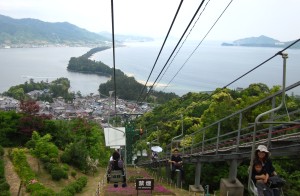 The isthmus is best viewed from two lookout points, one on each side of the sandbar itself. Chairlifts will bring you up to the lookouts, and you can walk the entire length of the long spit of land as well, as it is a gorgeous park. If it’s hot, feel free to bring a bathing suit and make use of the beaches facing onto beautiful waters!
The isthmus is best viewed from two lookout points, one on each side of the sandbar itself. Chairlifts will bring you up to the lookouts, and you can walk the entire length of the long spit of land as well, as it is a gorgeous park. If it’s hot, feel free to bring a bathing suit and make use of the beaches facing onto beautiful waters!
Nariai-ji is located on the north end of the Amanohashidate sandbar. As is perhaps fitting for its lovely locale, the temple is dedicated to the aesthetic of beauty, and the Kannon image enshrined here is known as the Bijin (beautiful) Kannon. The Kannon image type is the Sho Kannon, and it is displayed only once every 33 years. It is said that if you pray to this Kannon, you will become beautiful. Both the secret Kannon image and the maedachi that stands in front of the zushi were carved sometime in the Heian era (794 – 1185).
According to legend, Nariai-ji was founded in 704 by a wandering holy man named Shinno Shonin who lived in a hermitage up on the mountain. One winter, the villagers were unable to get food up the mountain because of the intensity of the winter snowfall. He prayed to Kannon, and a wounded deer appeared. Although he was loath to harm the creature, he knew it to be a gift from Kannon, so he took just enough to sustain him from the deer’s thigh. When the villagers were able to get to him, they pointed out that the Kannon image in his hut had her leg cut. Shinno 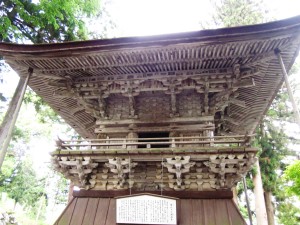 mended the self-sacrificing statue, and thus the temple was named nariai, meaning “neatly finishedâ€.
mended the self-sacrificing statue, and thus the temple was named nariai, meaning “neatly finishedâ€.
The hondo, built in 1779, was moved 2km down the mountain to make it more accessible to visitors because of that very severity of the winters on the San-in coast. The staff inside were quite friendly (and went so far as to insist that we take the bus back down the mountain rather than walk because of bear sightings), and 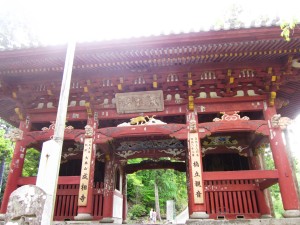 the temple felt very welcoming.
the temple felt very welcoming.
From the observation point on the north end of the isthmus, you can take a bus to the temple, or you can hoof it; the walk is not long, but it is steep. The temple gate appears first, then a garden next to the 5-story pagoda which is shiny and new and sticks out amidst the rest of the older wooden structures. Completed in 2005, it contains relics of the Buddha donated by a temple in Sri Lanka.
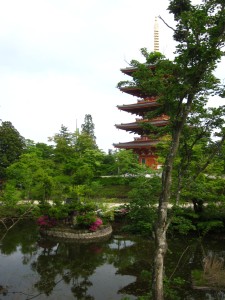 You’ll notice that the temple bell is not available for ringing. The story goes that in 1609, when the bell was cast, many local people came to watch. One woman holding a baby got too close, and the child fell into the molten bronze and died. The bell was rung once when it was dedicated, and sounded like the crying of a baby. This made everyone so sad that it was decided the bell will never be rung again.
You’ll notice that the temple bell is not available for ringing. The story goes that in 1609, when the bell was cast, many local people came to watch. One woman holding a baby got too close, and the child fell into the molten bronze and died. The bell was rung once when it was dedicated, and sounded like the crying of a baby. This made everyone so sad that it was decided the bell will never be rung again.
The hand and mouth purification fountain is also special. The water is drawn from a mountain spring 2km away at the original site of the temple; it is delicious and cold all year round. The basin it sits on, cast in 1209, looks like an iron bathtub, and may have been used for boiling large quantities of water.
Take a walk, say a prayer, taste the ice cream, and enjoy exploring Nariai-ji and Amanohashidate!
For more information on transportation, check out http://www.japan-guide.com/e/e3995.html and http://www.japan-guide.com/e/e3991.html. From some parts of Hyogo, it’s quite convenient to drive up this way, especially if you can get people to split gas and tolls with you.
For more legends about Nariai-ji, have a look at http://sacredjapan.com/Temple%2028/Legends28.htm!
Happy pilgriming!
Lemmon
Picture: http://sacredjapan.com/Temple%2028/maedachi.jpg
Postcard: http://31.media.tumblr.com/c19e3ec78c3e0c67b0a44a9063a204ad/tumblr_mh1v4z6uxV1rkytjko1_1280.jpg





